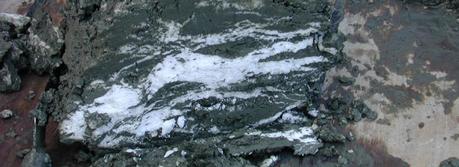
Structure of a gas hydrate (methane clathrate) block embedded in the sediment of hydrate ridge, off Oregon, USA. The gas hydrates have been found during a reasearch cruise with the German research ship FS SONNE in the subduction zone off Oregon in a depth of about 1200 meter in the upper meter of the sediment. The shown gas hydrate (white) has been deposited in thin layers into the sediment (Credit: Wusel007, http://commons.wikimedia.org/wiki/User:Wusel007)
Scientists from Georgia Institute of Technology have developed innovative tools for studying methane hydrate samples found under sediments on the ocean floors. An international team of scientists have recently used thouse tools in a groundbreaking research of natural gas hydrates and their potential usage as an energy source. The worldwide amount of carbon bound in gas hydrates is conservatively estimated to total twice the amount of carbon to be found in all known fossil fuels on Earth.
“There may be more carbon trapped in methane hydrate than in all petroleum, coal and gas reserves in the world,” said Carlos Santamarina, professor in the School of Civil and Environmental Engineering. “Our goal at Georgia Tech is to find ways to extract the methane, while at the same time trapping CO2 in the subsurface.”
During a recent trip to Sapporo, scientists from Georgia Tech, the U.S. Geological Survey and Japanese organizations analyzed methane gas hydrate in its natural, stable condition using the specialized devices designed and built by Georgia Tech.
Such well-preserved samples, which were recovered beneath the deep seafloor in the Nankai Trough offshore Japan, are extremely rare. Georgia Tech’s tools allowed scientists to conduct a complete study on the fundamental properties of gas hydrates for the first time.
“This research will not only help us understand the character of gas hydrates in Japan, but we can also apply that knowledge as well as this innovative technology and approach to understand the potential in the U.S. and around the world,” said Brenda Pierce, USGS Energy Resources program coordinator.
Gas hydrates are ice-like substances that naturally form when methane combines with water at specific temperatures and pressures. They are mostly found beneath deepwater marine settings and permafrost areas.
Dubbed “burning ice,” gas hydrates release enough methane to sustain a flame when they melt, making them a potentially significant source of natural gas. Scientists are also studying gas hydrates because they may contribute to global warming and could represent a threat to deep-sea petroleum production.
Gas hydrates are only stable at certain pressures and temperatures. Scientists have been working since the 1990s on sophisticated techniques to retrieve and preserve samples as “pressure cores,” keeping the gas as if it were still at its natural conditions in the subsurface where it formed.
Georgia Tech developed Pressure Core Characterization Tools with long-term support from the U.S. Department of Energy and the Gulf of Mexico Gas Hydrate Joint Industry Project. The tools allow the measurement of fundamental properties of gas hydrates, such as bioactivity, strength, compressibility, gas and water permeability, and sediment response during gas production.
All these tests are conducted in fully instrumented high-pressure chambers. Hydrate bearing sediments are maintained in their natural state at all times. The tools and test protocols are designed to cut and sub-sample cores, to transfer samples and to test them without ever depressurizing the core.
“This is a big step for the Japanese and U.S. scientists,” said Sheng Dai, a Ph.D. student in Santamarina’s lab who helped develop the tools and went to Japan to test them. “Learning more about the properties can help us understand how methane can be recovered from the sediments, which would have a big impact on our energy situation.”
The recent project is part of a multiyear program in deepwater gas hydrate exploration and production currently underway in Japan. The program is being led by the Japan Oil, Gas and Metals National Corporation (JOGMEC) and Japan’s National Institute of Advanced Industrial Science and Technology (AIST). Japanese researchers will soon be conducting the first offshore production test to track how much methane can be released from deepwater gas hydrate deposits.
The collaborative research in Japan was financially supported by USGS, the MH21 Research Consortium, the U.S. Department of Energy and the multinational Gulf of Mexico Gas Hydrates Joint Industry Project.
Santamarina and his graduate students – Dai, Junbong Jang, Marco Terzariol and Efthymios Papadopoulos – said the trip was a chance to take on some of the most challenging energy problems by developing unprecedented engineering solutions.
“The opportunities that Georgia Tech and Dr. Santamarina have given me are one of a kind,” Terzariol said. “No one else has done it before. And with the data and new questions that we brought, the idea now is to continue working and improving.”
Santamarina, J., Dai, S., Jang, J., & Terzariol, M. (2012). Scientific Drilling Scientific Drilling (14, September 2012) DOI: 10.2204/iodp.sd.14.06.2012

